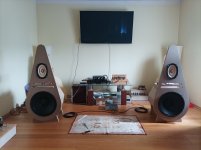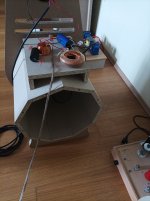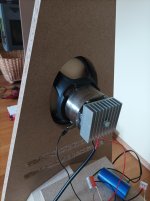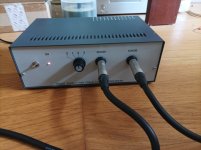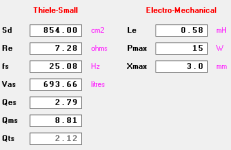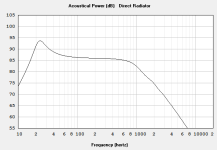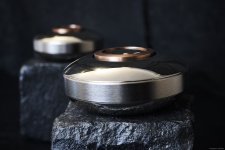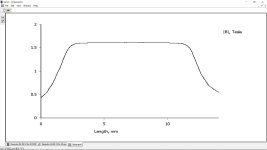Promise is a promise.
After too long I finally got around to making new speakers.
The project is still a test for now. Hence the use of materials. Crossover is still 1.0 version for now. The units are still new.
I used the SB 15OB350 for the bass and the Sonido FC SWR 096 for the FR.
The sound is very good right from the start. Maybe I caught the frequency cut quite well.
A few more pictures:
After too long I finally got around to making new speakers.
The project is still a test for now. Hence the use of materials. Crossover is still 1.0 version for now. The units are still new.
I used the SB 15OB350 for the bass and the Sonido FC SWR 096 for the FR.
The sound is very good right from the start. Maybe I caught the frequency cut quite well.
A few more pictures:
Attachments
Re specs, I've 'interpreted' some of Lii's specs and made some assumptions based on actual measured specs of other models (Le, Xmax), which historically had pretty far apart responses, but these actually work out once you ignore all the extra 'doodling', though its 95.6 dB SPL is quite optimistic as is the usual case. 🙁
Comparison:
Comparison:
Attachments
They come that way. Here’s a pic of mine.
I was looking for a more attractive solution since my drivers are also used on an open baffle.
I recently came across and ordered some LED heatsinks to swap on mine. They should do the same job…except prettier 😉.



I was looking for a more attractive solution since my drivers are also used on an open baffle.
I recently came across and ordered some LED heatsinks to swap on mine. They should do the same job…except prettier 😉.
Whats the commonly observed sensitivity rating of a speaker like this? I haven't owned any field coil drivers before, but heard a few of them at various shows. There's a sense of immediacy in the lower mids I haven't heard with most other permanent magnet type motor drivers. Is it feasible to design / build a higher power and output field coil speaker for PA type designs?
I attached some examples of driver measurements that were previously posted by Istvan of Sonido. It appears that the amount of current run through the electro-magnet can affect sensitivity.
Also, ghemml is an active member here and over at the Lowther Modification Support Group on Facebook. I’m not on Facebook.
I have had communication with him discussing field coil design and building and purchased parts for my own Lowther based field coil project from him. He has built Altec 416/515 based field coils as I understand it (if that is “PA” type).
Here’s a thread where he shows off some of the work from the group…
https://www.diyaudio.com/community/...by-lowther-modification-support-group.385905/


Also, ghemml is an active member here and over at the Lowther Modification Support Group on Facebook. I’m not on Facebook.
I have had communication with him discussing field coil design and building and purchased parts for my own Lowther based field coil project from him. He has built Altec 416/515 based field coils as I understand it (if that is “PA” type).
Here’s a thread where he shows off some of the work from the group…
https://www.diyaudio.com/community/...by-lowther-modification-support-group.385905/
Like a modern driver it's Qts dependent, though can go down to as little as < 0.1 Qt, lower than we can make even with neodymium magnets AFAIK, so combined with no thermal power distortion, the driver to have for truly 'heart attack fast' transients.Whats the commonly observed sensitivity rating of a speaker like this?
Can't imagine a Qts under 0.2 being practical for a horn loaded cone driver. The low end response would be slim to none.
Lowest Qts I've seen was 0.12 on a custom 12" midbass with an EBP of 720. The upper pole plate thickness was. 0.625" with a 0.750" VC height, with 20 x 1.5" dia x 2" tall N52 neo slugs. Testing the impulse response with a 6V battery sounded like a deadblow hammer hitting a plywood wall.
Haven't seen much higher than 2.1 Tesla saturation in the gap, but some older fostex ring radiators get close as well as newer neo HF drivers.
Lowest Qts I've seen was 0.12 on a custom 12" midbass with an EBP of 720. The upper pole plate thickness was. 0.625" with a 0.750" VC height, with 20 x 1.5" dia x 2" tall N52 neo slugs. Testing the impulse response with a 6V battery sounded like a deadblow hammer hitting a plywood wall.
Haven't seen much higher than 2.1 Tesla saturation in the gap, but some older fostex ring radiators get close as well as newer neo HF drivers.
hats the commonly observed sensitivity rating of a speaker like this?
Depends on the voltage. Turn it up Q drops and (midband) efficiency increases.
dave
Last edited:
That's because you apparently didn't grow up listening to them coupled to high - matching impedance tube (pre) amps, receivers with variable DF tone controls. 

You guys are talking in circles over my head regarding parameters and their effects.
I will say my Sonido field coils have a most agreeable midrange and over all balance that I enjoy.
I use them with my DIY F2J monoblocks. I’ve tried several other First Watt Class A DIY amps and derivatives as well as VFETs and some Quicksilver Horn Monos. I thought the tube amps would be the best match, but I always tend to go back to the F2J.
A pair of Lii Audio alnico Crystal 10 drivers I have are similarly enjoyable.
W8-1808 Tang Bands were dull and muted to me and eventually I got rid of them.
I enjoy modified Fostex 206e drivers on a daily basis. They do everything well, perhaps nothing spectacularly. I have some used 206esr that need repair and 208 sigma. I haven’t tried either yet.
Lowther has been a love/hate experience. The DX3 drivers I still have were in front horns. The detail and imaging was spectacular. I was able to tame the shouting quite a bit using a First Watt B5. Eventually the “head in a vice” beaming became unbearable. I have some used pm6a that need repair and I am interested in building field coil motors to try with one of the Lowthers on open baffle. My experience with the Sonidos brought that on.
In my discussions with a more experienced field coil builder it was pointed out to me that although many take the approach that “more is better”, that a field coil motor with a gap saturation of about 1.3 Tesla tends to be the sweet spot for a lot of builders of “fullrange” type drivers. They said that pushing beyond that point in saturation tends to bring on “edginess” and shouting.
Field coil woofers are probably a completely different animal? I won’t know until I try it myself.
I will say my Sonido field coils have a most agreeable midrange and over all balance that I enjoy.
I use them with my DIY F2J monoblocks. I’ve tried several other First Watt Class A DIY amps and derivatives as well as VFETs and some Quicksilver Horn Monos. I thought the tube amps would be the best match, but I always tend to go back to the F2J.
A pair of Lii Audio alnico Crystal 10 drivers I have are similarly enjoyable.
W8-1808 Tang Bands were dull and muted to me and eventually I got rid of them.
I enjoy modified Fostex 206e drivers on a daily basis. They do everything well, perhaps nothing spectacularly. I have some used 206esr that need repair and 208 sigma. I haven’t tried either yet.
Lowther has been a love/hate experience. The DX3 drivers I still have were in front horns. The detail and imaging was spectacular. I was able to tame the shouting quite a bit using a First Watt B5. Eventually the “head in a vice” beaming became unbearable. I have some used pm6a that need repair and I am interested in building field coil motors to try with one of the Lowthers on open baffle. My experience with the Sonidos brought that on.
Haven't seen much higher than 2.1 Tesla saturation in the gap
In my discussions with a more experienced field coil builder it was pointed out to me that although many take the approach that “more is better”, that a field coil motor with a gap saturation of about 1.3 Tesla tends to be the sweet spot for a lot of builders of “fullrange” type drivers. They said that pushing beyond that point in saturation tends to bring on “edginess” and shouting.
Field coil woofers are probably a completely different animal? I won’t know until I try it myself.
I used to design 6x9 full range drivers when I worked at Jensen. Elliptical drivers inherently have less pronounced, more evenly distributed resonances (“eigenmodes”) than round drivers.
If 6x9s were not associated in most peoples’ minds with 80s car stereo, they would be employed much more in hi fi.
If you put a gun to my head and said “design a full range speaker, you only get to use one driver” I’d put a dual-come 5x7 or 6x9 in a back loaded horn or large transmission line.
If 6x9s were not associated in most peoples’ minds with 80s car stereo, they would be employed much more in hi fi.
If you put a gun to my head and said “design a full range speaker, you only get to use one driver” I’d put a dual-come 5x7 or 6x9 in a back loaded horn or large transmission line.
dual-come 5x7
I have a couple nice ones in my give away stash.
The 6x9 out of many early GMs (Delco) is goos and i found all mine at garage sales for usually only a couple bucks,
dave
I listen to the speakers for a couple of hours a day. I also test different crossovers.
For now, just hearsay. I changed the caps on the Sonido SWR96 for better ones.
Then I test a combination of top quality and high class. I also tested without crossover on Sonido SWR 96A.
And I finally went back to the original crossover, with the original test material, because it sounds the best.
Next week I will do more measurements with the microphone.
For now, just hearsay. I changed the caps on the Sonido SWR96 for better ones.
Then I test a combination of top quality and high class. I also tested without crossover on Sonido SWR 96A.
And I finally went back to the original crossover, with the original test material, because it sounds the best.
Next week I will do more measurements with the microphone.
Hi,Can't imagine a Qts under 0.2 being practical for a horn loaded cone driver. The low end response would be slim to none.
Lowest Qts I've seen was 0.12 on a custom 12" midbass with an EBP of 720. The upper pole plate thickness was. 0.625" with a 0.750" VC height, with 20 x 1.5" dia x 2" tall N52 neo slugs. Testing the impulse response with a 6V battery sounded like a deadblow hammer hitting a plywood wall.
Haven't seen much higher than 2.1 Tesla saturation in the gap, but some older fostex ring radiators get close as well as newer neo HF drivers.
Please don´t misunderstand - no offence intended, but I would love to see a driver with 2,1 T in the airgap - measured, not just claimed.
The trouble is that low carbon steels saturate around 2 T, depending on carbon content. Very expensive (and difficult to machine) Pure Iron saturates at 2,18 T, even more expensive Permendur saturates at 2,35 T.
If you manage to saturate the steel inside and outside of the airgap (which does not only require very strong magnets, but also requires to get the geometry right. Just massive slabs of neodymium or giant field coils are not enough), the air in the airgap will significantly reduce the T value in the middle of the airgap, where the coil is.
For 2,1 T in the airgap all steel parts have to be made from Pure Iron or better, and the airgap width has to be nearly 0. That is not feasable...
I hope I´m allowed to add an example from real life, built, tested and measured:
My own motors have custom made Pure Iron steel parts (these cost several hundred € alone) and a custom made N52 magnet. Poleplate and core (the core is the culprit...) are fully saturated at 2,18 T.
In the middle of the 40 mm x 10 mm airgap with a width of 1,3mm (a bit of which is occupied by a copper cap, the remaining width is needed for reliable centering) magnetic strength is reduced to 1,54 T due to the air in the airgap, this is what remains of the 2,18 T.
This has been measured.
Of course, the driver with a Qts of 0,13 is nearly unusable for bass (and that was never intended) and is a high speed and high resolution device, not a universal solution.
Please accept my apologies for the off-topic content. Back to Sonido. Would have loved to make an oval driver myself, but a round one was a lot easier...
All the best
Mattes
Attachments
- Home
- Loudspeakers
- Full Range
- Sonido Field Coil SWR096 in OB
